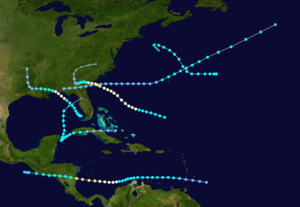1911 Atlantic hurricane season
| 1911 Atlantic hurricane season | |
|---|---|

Season summary map
|
|
| Seasonal boundaries | |
| First system formed | February 20, 1911 |
| Last system dissipated | December 13, 1911 |
| Strongest storm | |
| Name | Three |
| • Maximum winds | 100 mph (155 km/h) (1-minute sustained) |
| • Lowest pressure | 972 mbar (hPa; 28.7 inHg) |
| Seasonal statistics | |
| Total depressions | 9 |
| Total storms | 6 |
| Hurricanes | 3 |
| Total fatalities | >27 |
| Total damage | $3 million (1911 USD) |
| Tropical storm (SSHWS) | |
| Duration | August 4 – August 12 |
|---|---|
| Peak intensity | 60 mph (95 km/h) (1-min) <1007 mbar (hPa) |
| Category 1 hurricane (SSHWS) | |
| Duration | August 8 – August 14 |
|---|---|
| Peak intensity | 80 mph (130 km/h) (1-min) 982 mbar (hPa) |
| Category 2 hurricane (SSHWS) | |
| Duration | August 23 – August 30 |
|---|---|
| Peak intensity | 100 mph (155 km/h) (1-min) 972 mbar (hPa) |
| Category 2 hurricane (SSHWS) | |
| Duration | September 3 – September 12 |
|---|---|
| Peak intensity | 100 mph (155 km/h) (1-min) <990 mbar (hPa) |
| Tropical storm (SSHWS) | |
| Duration | September 15 – September 19 |
|---|---|
| Peak intensity | 65 mph (100 km/h) (1-min) <995 mbar (hPa) |
| Tropical storm (SSHWS) | |
| Duration | October 26 – October 31 |
|---|---|
| Peak intensity | 50 mph (85 km/h) (1-min) <1006 mbar (hPa) |
The 1911 Atlantic hurricane season was relatively inactive, with only six known tropical cyclones forming in the Atlantic during the summer and fall. There were three suspected tropical depressions, including one that began the season in February and one that ended the season when it dissipated in December. Three storms intensified into hurricanes, two of which attained Category 2 status on the modern-day Saffir–Simpson Hurricane Scale. Storm data is largely based on the Atlantic hurricane database, which underwent a thorough revision for the period between 1911 and 1914 in 2005.
Most of the cyclones directly impacted land. A westward-moving hurricane killed 17 people and severely damaged Charleston, South Carolina, and the surrounding area in late August. A couple of weeks earlier, the Pensacola, Florida area had a storm in the Gulf of Mexico that produced winds of 80 mph (130 km/h) over land. The fourth storm of the season struck the coast of Nicaragua, killing 10 and causing extensive damage.
The Atlantic hurricane database (HURDAT) officially recognizes six tropical cyclones from the 1911 season. Only three attained hurricane status, with winds of 75 mph (121 km/h) or greater. The third hurricane of the season was the most intense storm, with a minimum central air pressure of 972 mbar (28.7 inHg). A week after its dissipation, another hurricane formed with wind speeds that matched the previous storm, but with unknown air pressure. Three weak tropical depressions developed and remained below tropical storm force; the first formed in February and the third in December. The first storm to reach tropical storm intensity developed on August 4, and the final tropical storm of the year dissipated on October 31.
The early 1900s lacked modern forecasting and documentation. The hurricane database from these years is sometimes found to be incomplete or incorrect, and new storms are continually being added as part of the ongoing Atlantic hurricane reanalysis. The period from 1911 through 1914 was reanalyzed in 2005. Two previously unknown tropical cyclones were identified using records including historical weather maps and ship reports, and information on the known storms was amended and corrected. These storms are referred to simply by their number in chronological order, since tropical cyclones in the Atlantic Ocean were not given official names until much later.
...
Wikipedia












